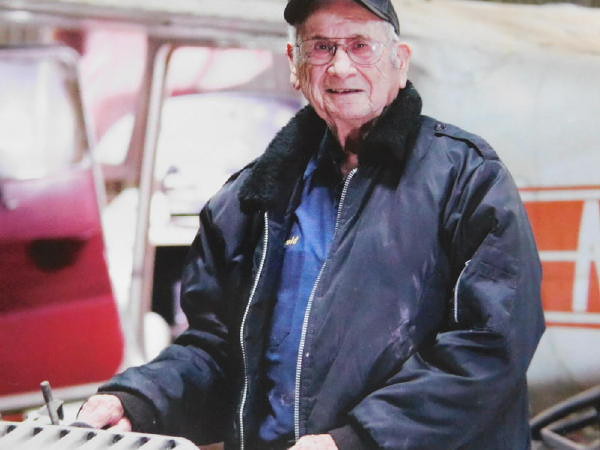~ D-DAY, June 6, 1944 ~ 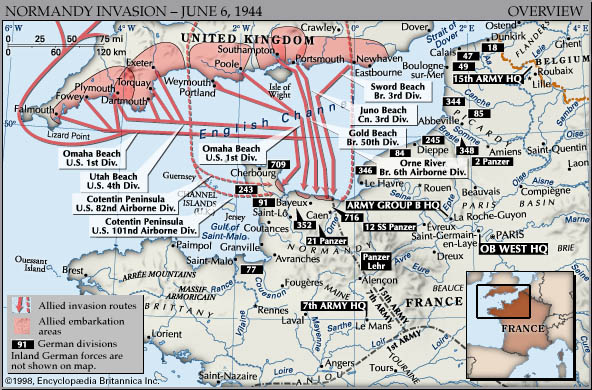 NORMANDY INVASION May 1944 had been chosen at the conference in Washington in May 1943 as the time for the invasion. Difficulties in assembling landing craft forced a postponement until June, but June 5 was fixed as the unalterable date by Eisenhower on May 17. As the day approached and troops began to embark for the crossing, bad weather set in, threatening dangerous landing conditions. After tense debate, Eisenhower and his subordinates decided on a 24-hour delay, requiring the recall of some ships already at sea. Eventually, on the morning of June 5, Eisenhower, assured by chief meteorologist James Martin Stagg of a break in the weather, announced, “O.K. We’ll go”. Within hours an armada of 3,000 landing craft, 2,500 other ships, and 500 naval vessel, escorts, and bombardment ships began to leave English ports. That night 822 aircraft, carrying parachutists or towing gliders, roared overhead to the Normandy landing zones. They were a fraction of the air armada of 13,000 aircraft that would support D-Day.
      
Canteen Mission Statement
Showing support and boosting the morale of
our military and our allies' military
and family members of the above.
Honoring those who have served before.

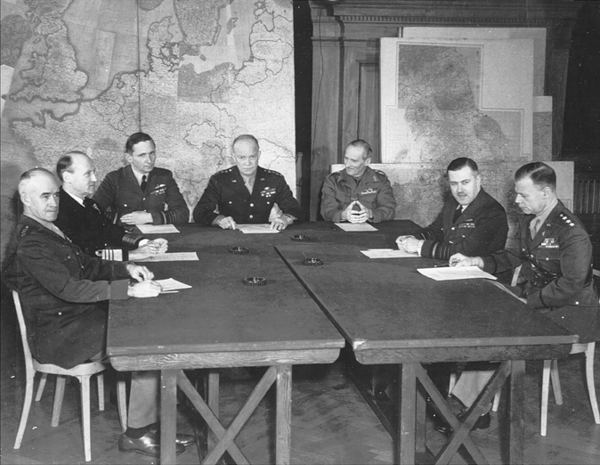
January 1944 meeting of Operation Overlord Commanders, General Eisenhower, Walter B. Smith, Omar Bradley, Arthur Tedder, Bernard Montgomery, Trafford Leigh-Mallory and Bertram Ramsay. The Eisenhower Presidential Library 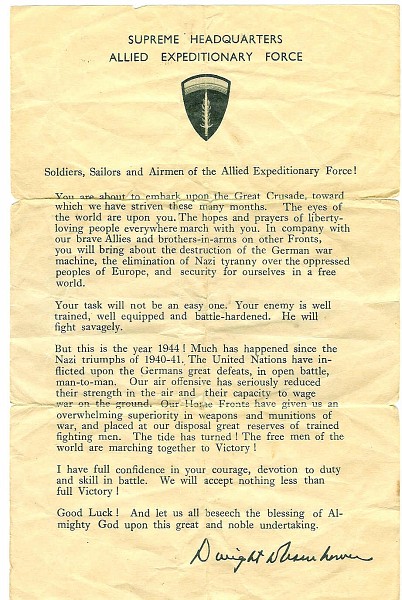 GENERAL EISENHOWER’S MESSAGE SENT JUST PRIOR TO THE INVASION Soldiers, Sailors and Airmen of the Allied Expeditionary Force! You are about to embark upon a great crusade, toward which we have striven these many months. The eyes of the world are upon you. The hopes and prayers of liberty loving people everywhere march with you. In company with our brave Allies and brothers in arms on other fronts, you will bring about the destruction of the German war machine, the elimination of Nazi tyranny over the oppressed peoples of Europe, and security for ourselves in a free world. Your task will not be an easy one. Your enemy is well trained, well equipped and battle hardened, he will fight savagely. But this is the year 1944! Much has happened since the Nazi triumphs of 1940-41. The United Nations have inflicted upon the Germans great defeats, in open battle, man to man. Our air offensive has seriously reduced their strength in the air and their capacity to wage war on the ground. Our home fronts have given us an overwhelming superiority in weapons and munitions of war, and placed at our disposal great reserves of trained fighting men. The tide has turned! The free men of the world are marching together to victory! I have full confidence in your courage, devotion to duty and skill in battle. We will accept nothing less than full victory! Good Luck! And let us all beseech the blessings of Almighty God upon this great and noble undertaking. -- Gen. Dwight D. Eisenhower 
D-DAY AIRBORNE AND BEACH ASSAULT The Normandy beaches were chosen by planners because they lay within range of air cover, and were less heavily defended than the obvious objective of the Pas de Calais, the shortest distance between Great Britain and the Continent. Airborne drops at both ends of the beachheads were to protect the flanks, as well as open up roadways to the interior. Six divisions were to land on the first day; three U.S., two British and one Canadian. Two more British and one U.S. division were to follow up after the assault division had cleared the way through the beach defenses. Click for the rest of the story
 American Patrol The Army Air Corps
G I Jive A Fellow On A Furlough A Nightingale Sang In Berkeley Square
  CHANCE MEETING BRINGS CAVALRY SERGEANT FACE-TO-FACE WITH D-DAY VETERAN Sgt. 1st Class Steve Selvage of the 3rd Squadron, 2nd Stryker Cavalry Regiment gets an autograph from 91-year-old D-Day survivor Ralph Manley in Sainte Mere Eglise, France, June 1, 2006. The two met while Selvage was in town to participate in events commemorating the 65th anniversary of the Normandy invasion. Click for the rest of the story 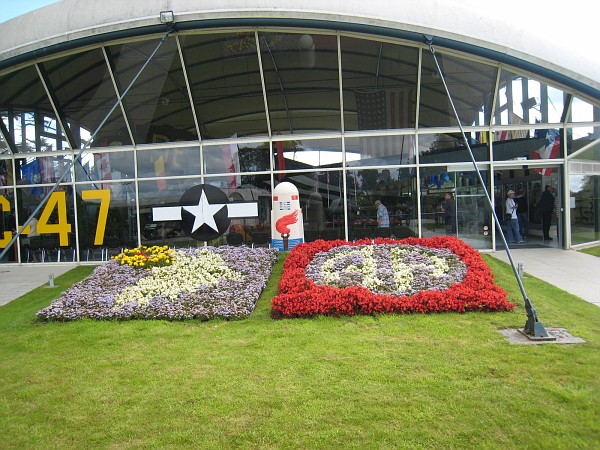
AIRBORNE MUSEUM HOUSES ONE-OF-A-KIND ARTIFACTS
THAT HONOR HISTORIC JUMP DURING D-DAY INVASION SAINTE MERE EGLISE, France - This town loves paratroopers - in particular, American paratroopers from the 82nd Airborne and the 101st Airborne Divisions. It was those two divisions that liberated Sainte Mere Eglise June 7, 1944, making it the first town in France to be liberated during World War II. To show their appreciation for the veterans, an Airborne Museum opened here in 1964. A non-profit organization, all proceeds go back into the museum to pay for upkeep, new exhibits or extensions. The money is also used to provide decorations and celebrations for the anniversary of D-Day, travel for veterans, and exhibitions outside France. A large donation was also made to The National World War II museum in New Orleans, La. The rest of the story  Bugle Call Rag Dont Sit Under The Apple Tree Jeep Jockey Jump Moonlight Serenade Enlisted Men's Mess
  SOLDIERS PREP TO SUPPORT D-DAY CEREMONIES FOR
65TH ANNIVERSARY OF INVASION Senior staff members of Task Force Normandy 65 pose in front of a German gun post at Pointe du Hoc, France. Task Force Normandy 65 is in France providing support and ceremonial command and control for the 65th anniversary of D-Day, June 6. Pointe du Hoc is the site of the 2nd Ranger Battalion's assault on a German stronghold during D-Day. Photo credit Sgt. Fay Conroy, 21st Theater Sustainment Command Public Affairs Click for the rest of the story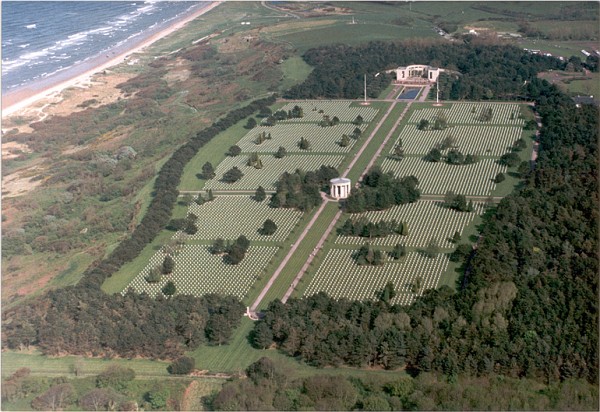
NORMANDY AMERICAN CEMETERY AND MEMORIAL The Normandy American Cemetery and Memorial in France is located on the site of the temporary American St. Laurent Cemetery, established by the U.S. First Army on June 8, 1944 and the first American cemetery on European soil in World War II. The cemetery site, at the north end of its ½ mile access road, covers 172.5 acres and contains the graves of 9,387 of our military dead, most of whom lost their lives in the D-Day landings and ensuing operations. On the Walls of the Missing in a semicircular garden on the east side of the memorial are inscribed 1,557 names. Rosettes mark the names of those since recovered and identified. Click for the rest of the story 
Please remember that The Canteen is here to support
and entertain our troops and veterans and their families,
and is family friendly. |
|
|





















